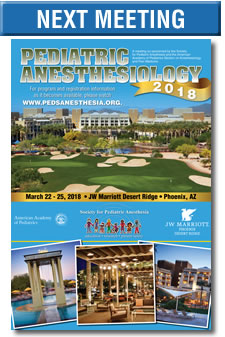Meeting Reviews
SPA Session 2 - What to Expect When You’re… Expecting Changes to the Healthcare Environment
Reviewed by Elizabeth Yun, MD
University of Wisconsin, Madison
This session featured two lectures on the many challenges of the evolving healthcare environment and what pediatric anesthesiologists can do to meet these changes.
Mary Dale Peterson, MD, CEO of Driscoll Children’s Hospital, gave the first lecture titled. "Healthcare Reform: So what does this mean for a Pediatric Anesthesiologist?" She began by stating that the cost of healthcare in the United States is 18% of GDP and on track to hit over $10,000 spending on healthcare per person. Despite the spending, this country ranks last worldwide in outcomes that measure a health life: mortality amenable to medical care, infant mortality and healthy life expectancy at age 60. While the US has high quality hospitals and treats acute diseases such as cancer well, it does not handle chronic disease management as effectively. Unlike other developed countries, the US spends less on social issues. Other factors for this discrepancy include higher obesity rates, low number of physicians and high hospital admissions for chronic disease.
In the next part of the lecture, Dr. Peterson discussed Medicaid, a jointly funded state-federal program to provide health coverage to low income and disabled people. Medicaid covers forty percent of children and almost half the births in this country. Nevertheless, the money available in Medicaid may be directed to other patient populations such as the elderly at the expense of children. She reviewed the various administrative structures in Medicaid such as managed care, capitation and subcapitation and ACOs. She discussed the ACA, a program to help the uninsured get commercial coverage with essential benefits and the various repeal and replace acts that have been presented to Congress this past year. Dr. Peterson reviewed the many ways hospitals get paid including fee for service, per diem, DRG, a prospective payment system and TEFRA payment that helps cover safety net hospitals. Because these methods do not cover all the costs there are government supplemental payments for safety net hospitals such as Disproportionate Share Payments, Upper Payment Limit payments and intergovernmental transfers that include the 1115 waiver delivery supplemental reform improvement payments and uncompensated care pools.
In the last part of the lecture, Dr. Peterson discussed the role of the pediatric anesthesiologist in this new healthcare environment. She noted that many pediatric anesthesiologists are subsidized by the hospital. Therefore, the challenge for anesthesiologists is to show their value to hospital administration with coverage, quality of care, patient and surgeon satisfaction and efficiency. She concluded by providing an example of how to do this. The operating rooms at Driscoll Children’s Hospital did not have enough capacity so she looked for preventable conditions that could reduce OR utilization. She discovered that patients with early childhood dental caries, one of the most common childhood diseases, had to come to the OR for dental surgery. By working with the pediatric dentists and the pediatricians, they came up with a simple solution of fluoride varnish placed during infancy that dramatically decreased the incidence of caries. With this program, Healthy Smiles, they saw a 99% reduction in the need for surgeries in patients that had the varnish and that led to 8.5 million dollars in savings over five years.
Tetsu Uejima, MD, Chair, Department of Pediatric Anesthesiology and Perioperative Medicine at Nemours/Al duPont Hospital for Children, presented the lecture How Can I Survive in the New Economics of Healthcare? The major objectives of his lecture discussed how to stay financially viable in today’s healthcare market and the meaning of value in today’s world. Hospitals are facing an alarming trend of decreased operating margins because of increased expenses and decreased revenues as reimbursement for healthcare decreases. Even increasing volume does not offset the lost revenue. There are now movements focusing on value and price transparency of healthcare that will also have significant impact on healthcare finances. He defined the meaning of value in this setting as outcomes over cost and for the purposes of this talk, focused on cost.
He described the shift away from fee for service models to value based systems and suggested that the way for hospital systems to stay profitable is to decrease costs proportionately. As healthcare out-of-pocket costs go up for patients, there will be a growing demand by patients wanting to know the costs of physicians and hospitals for procedures and to compare prices among different healthcare organizations. Therefore, costs must be justified and contained. He outlined the various costs involved with the OR: supplies (drugs and equipment), people and time with supplies contributing the least amount to overall costs. In this new healthcare environment there is a paradigm shift from the clinical model of do no harm to a value perspective of demonstrating actual improvement. He discussed the need for looking at various methods to decrease costs, such as standardization of care, since that improves patient safety and efficiency. He recommended educating staff about costs, and examining individual practitioner variability in drug and equipment use. By implementing these strategies, he demonstrated that his department decreased costs.
Another area of cost reduction is operating room time because this location is the most expensive unit on a cost per minute basis. He described ways his organization decreased anesthesia and surgical time for various procedures. He emphasized that anesthesiologists need to show their value by aligning goals with the hospital, coordinating perioperative care from preoperative to postoperative and by getting involved in programs addressing pain, sedation and drug diversion. He stressed the need to collaborate with other physicians for cost saving programs such as ERAS programs with surgeons. He concluded by stating that anesthesiologists need to be at the table to represent and protect their interests.






